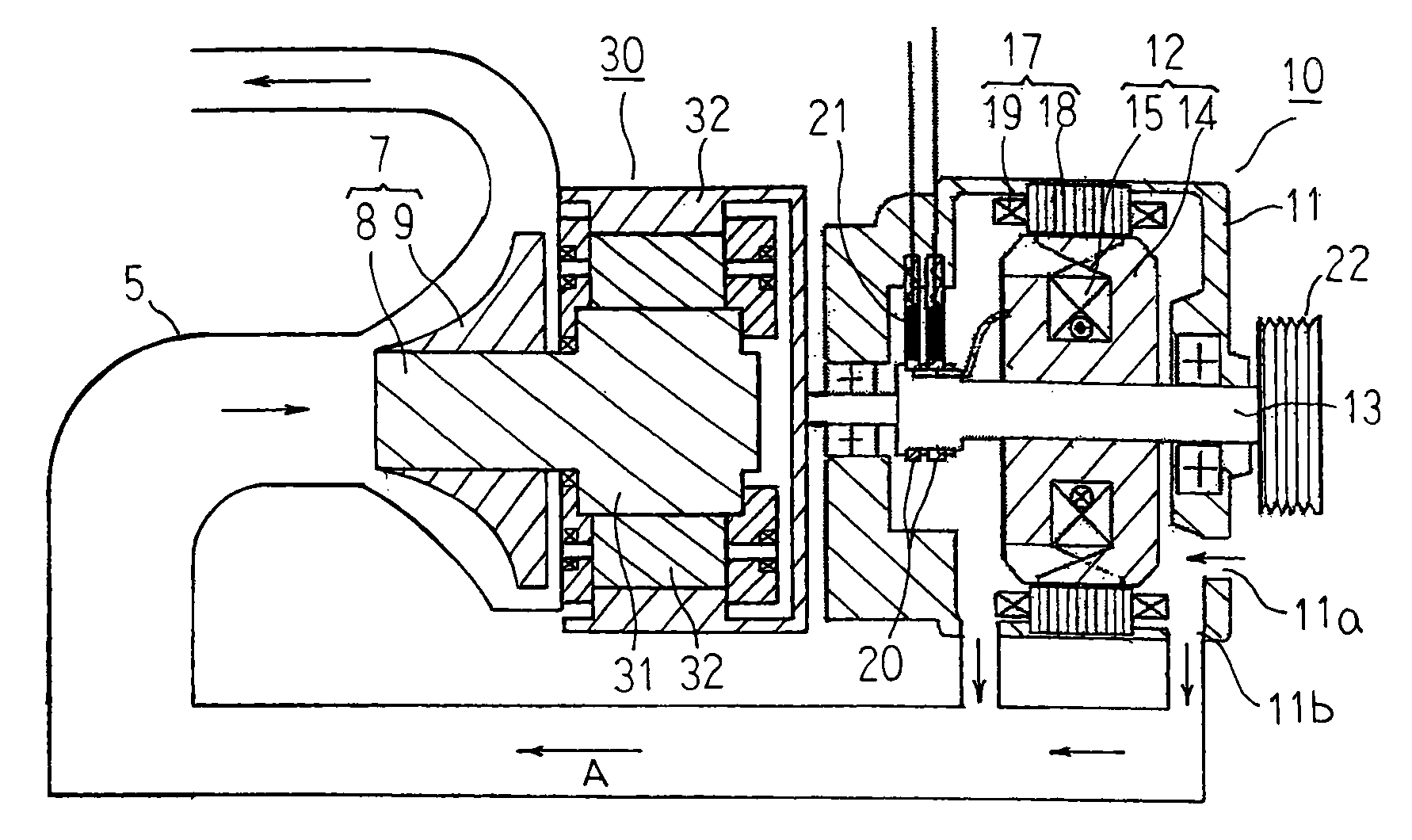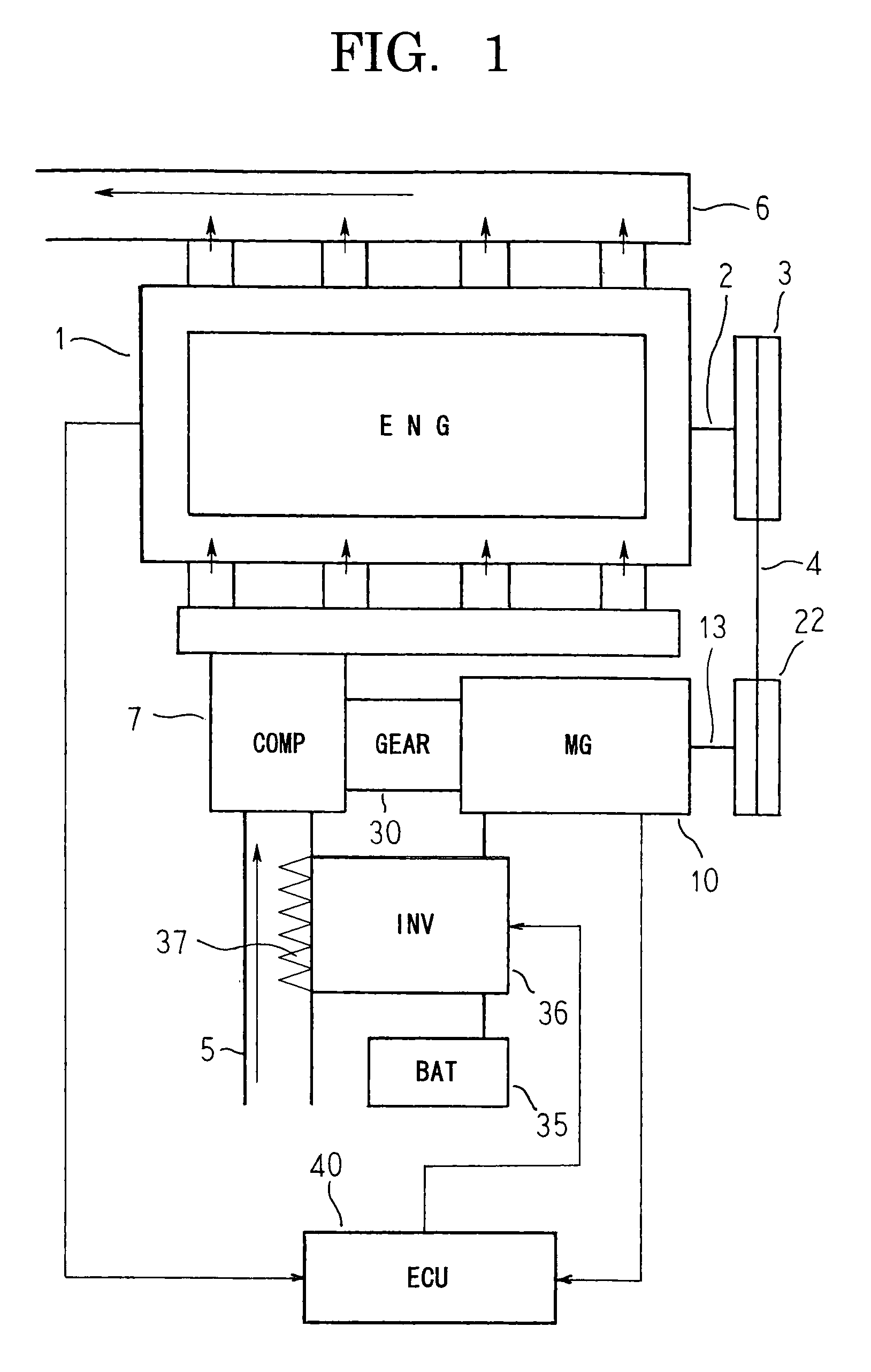Automotive supercharging apparatus
a supercharging apparatus and motor technology, applied in mechanical equipment, machines/engines, magnetic circuit shapes/forms/construction, etc., can solve the problems of insufficient supercharging capacity of centrifugal supercharging apparatus, limit to how much gear ratio can be increased, and insufficient supercharging capacity of low-speed regions, etc., to reduce costs, suppress the effect of inverter and battery capacity increase and boost pressur
- Summary
- Abstract
- Description
- Claims
- Application Information
AI Technical Summary
Benefits of technology
Problems solved by technology
Method used
Image
Examples
embodiment 1
[0026]FIG. 1 is a system configuration diagram that shows an automotive supercharging apparatus according to Embodiment 1 of the present invention, FIG. 2 is a cross section that schematically shows a power transmission pathway in the automotive supercharging apparatus according to Embodiment 1 of the present invention, and FIG. 3 is a cross section that shows a one-way clutch pulley that can be used in the automotive supercharging apparatus according to Embodiment 1 of the present invention.
[0027]In FIG. 1, air is supplied to an engine 1 by means of intake piping 5, and exhaust gas is discharged after combustion by means of exhaust piping 6. A crank pulley 3 is fixed to a crank shaft 2 that constitutes an output shaft of the engine 1.
[0028]An automotive supercharging apparatus includes: a compressor 7 that is disposed in the intake piping 5, and that compresses air that is supplied to the engine 1; an electric motor-generator 10 that includes an electric motor function and a genera...
embodiment 2
[0076]FIG. 4 is a system configuration diagram that shows an automotive supercharging apparatus according to Embodiment 2 of the present invention.
[0077]In FIG. 4, a first pulley 41 is fixed to a rotating shaft 13 alongside a one-way clutch pulley 22. An oil pump 42 includes a second pulley 44 that is fixed to a rotating shaft 43, and supplies oil to lubricate an epicyclic gear apparatus 30. A second belt 45 is looped around the first and second pulleys 41 and 44 so as to transmit driving torque from an electric motor-generator 10 to the oil pump 42.
[0078]Moreover, the rest of this embodiment is configured in a similar manner to Embodiment 1 above.
[0079]According to Embodiment 2, the oil pump 42 can be driven when the engine 1 is stopped by operating the electric motor-generator 10 as an electric motor. Thus, oil is constantly supplied to the epicyclic gear apparatus 30 from the oil pump 42 while the compressor 7 is driven at high speed by the electric motor-generator 10, enabling t...
embodiment 3
[0080]FIG. 5 is a system configuration diagram that shows an automotive supercharging apparatus according to Embodiment 3 of the present invention, and FIG. 6 is a cross section that schematically shows a power transmission pathway in the automotive supercharging apparatus according to Embodiment 3 of the present invention.
[0081]In FIGS. 5 and 6, an air intake aperture 11a and an air discharge aperture 11b are disposed on a housing 11 of an electric motor-generator 10, and intake piping 5 upstream from a compressor 7 is linked to the air discharge aperture 11b. Thus, an intake airflow A is formed in which air is sucked in through the air intake aperture 11a into the housing 11 by driving the compressor 7, cools a rotor 12 and a stator 17, is then discharged through the air discharge aperture 11b of the housing 11, flows through the intake piping 5, and is supplied to the compressor 7.
[0082]Moreover, the rest of this embodiment is configured in a similar manner to Embodiment 1 above....
PUM
 Login to View More
Login to View More Abstract
Description
Claims
Application Information
 Login to View More
Login to View More - R&D
- Intellectual Property
- Life Sciences
- Materials
- Tech Scout
- Unparalleled Data Quality
- Higher Quality Content
- 60% Fewer Hallucinations
Browse by: Latest US Patents, China's latest patents, Technical Efficacy Thesaurus, Application Domain, Technology Topic, Popular Technical Reports.
© 2025 PatSnap. All rights reserved.Legal|Privacy policy|Modern Slavery Act Transparency Statement|Sitemap|About US| Contact US: help@patsnap.com



